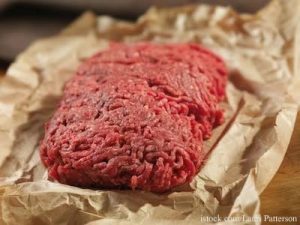The USDA’s Food Safety and Inspection Service (FSIS) announced today that it has finalized a rule to ensure that retailers can track sources of ground meats. Those products are often recalled and linked to food poisoning outbreaks. FSIS is requiring that all makers of raw ground beef products keep records of the source material so the agency can work with suppliers to recall contaminated products.
 Ground beef is often made with beef cuts that come from various sources. That increases the likelihood that contaminated meat will further contaminate a large amount of ground beef, and it makes the government’s work on tracing suppliers much more difficult. When stores make ground beef by combining beef from different sources and do not keep clear records, recalls become more complicated.
Ground beef is often made with beef cuts that come from various sources. That increases the likelihood that contaminated meat will further contaminate a large amount of ground beef, and it makes the government’s work on tracing suppliers much more difficult. When stores make ground beef by combining beef from different sources and do not keep clear records, recalls become more complicated.
This new requirement complements expedited traceback and trace forward procedures that were announced by FSIS in August 2014. Those requirements enhance the government’s ability to quickly investigate food safety breakdowns when an outbreak connected to ground beef occurs.
Deputy Under Secretary for Food Safety Al Almanza said in a statement, “this is a common sense step that can prevent foodborne illness and increase consumer confidence when they purchase ground beef. In the event that unsafe product does make it into commerce, these new procedures will give us the information we need to act much more effectively to keep families across the country safe.”
Under the new rule, all officials establishments and retail stores that grind raw beef products must maintain records. Those records must include the establishment numbers of facilities supplying material used to prepare each lot of round ground beef; all supplier lot numbers and production dates; the names of the supplied materials, including beef components and any materials carried over from one production lot to the next; the date and time each lot of raw ground beef product is produced; and the date and time when grinding equipment and other related food-contact surfaces are cleaned and sanitized. The requirements also apply to customized products that are made for an individual consumer.
Many retail stores produced raw ground beef by mixing cuts of beef from different sources around the country. A Salmonella outbreak in the northeastern United States in 2011 that was linked to ground beef could have been prevented if establishments that sold the product had kept supplier records on file. The rule 79 FR 42464 was published by FSIS in July 2014 as a result of this outbreak.
Other requirements that apply specifically to ground beef include a zero-tolerance policy for raw beef products that contain six strains of shiga-toxin producing E. coli bacteria (STEC), along with expanding testing procedures for additional components of ground beef. Improving employee training to detect E. coli O157:H7 contamination on beef carcasses is another tactic.




